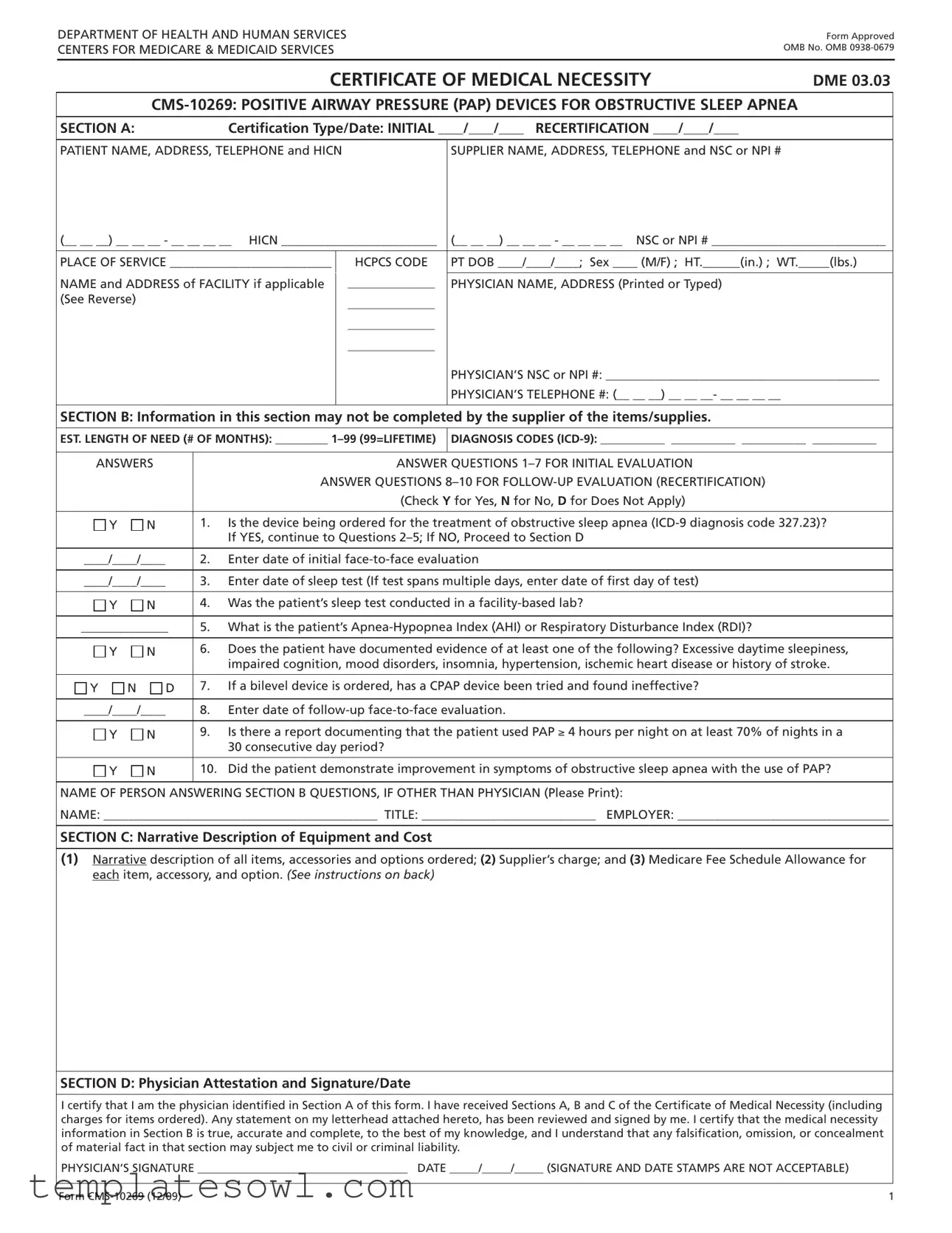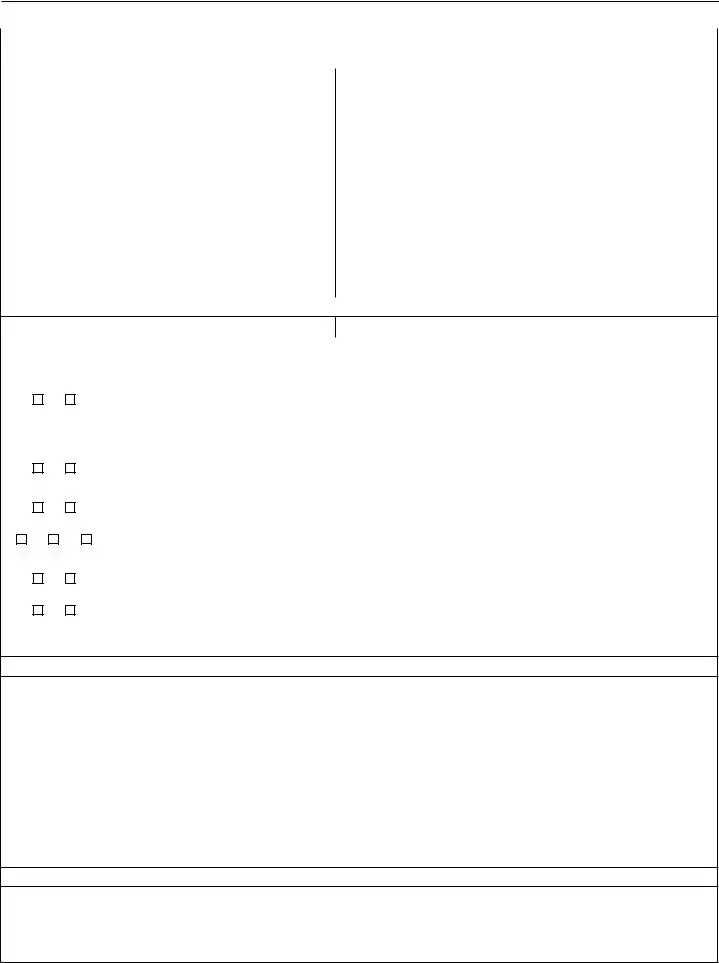DEPARTMENT OF HEALTH AND HUMAN SERVICES CENTERS FOR MEDICARE & MEDICAID SERVICES
Form Approved OMB No. OMB 0938-0679
|
|
|
|
|
CERTIFICATE OF MEDICAL NECESSITY |
DME 03.03 |
|
CMS-10269: POSITIVE AIRWAY PRESSURE (PAP) DEVICES FOR OBSTRUCTIVE SLEEP APNEA |
|
SECTION A: |
Certification Type/Date: INITIAL ____/____/____ RECERTIFICATION ____/____/____ |
|
|
|
|
PATIENT NAME, ADDRESS, TELEPHONE and HICN |
SUPPLIER NAME, ADDRESS, TELEPHONE and NSC or NPI # |
|
(__ __ __) __ __ __ - __ __ __ __ HICN _________________________ |
(__ __ __) __ __ __ - __ __ __ __ NSC or NPI # ____________________________ |
|
|
|
PLACE OF SERVICE __________________________ |
HCPCS CODE |
PT DOB ____/____/____; Sex ____ (M/F) ; HT.______(in.) ; WT._____(lbs.) |
NAME and ADDRESS of FACILITY if applicable |
________________ |
PHYSICIAN NAME, ADDRESS (Printed or Typed) |
(See Reverse) |
________________ |
|
|
|
|
________________ |
|
|
________________ |
|
|
|
PHYSICIAN’S NSC or NPI #: ____________________________________________ |
|
|
PHYSICIAN’S TELEPHONE #: (__ __ __) __ __ __- __ __ __ __ |
|
|
|
SECTION B: Information in this section may not be completed by the supplier of the items/supplies.
EST. LENGTH OF NEED (# OF MONTHS): _________ 1–99 (99=LIFETIME)
DIAGNOSIS CODES (ICD-9): ___________ ___________ ___________ ___________
ANSWERS |
|
|
ANSWER QUESTIONS 1–7 FOR INITIAL EVALUATION |
|
|
|
|
ANSWER QUESTIONS 8–10 FOR FOLLOW-UP EVALUATION (RECERTIFICATION) |
|
|
|
|
(Check Y for Yes, N for No, D for Does Not Apply) |
|
|
|
|
|
Y |
N |
|
1. |
Is the device being ordered for the treatment of obstructive sleep apnea (ICD-9 diagnosis code 327.23)? |
|
|
|
|
If YES, continue to Questions 2–5; If NO, Proceed to Section D |
____/____/____ |
|
2. |
Enter date of initial face-to-face evaluation |
|
|
|
|
____/____/____ |
|
3. |
Enter date of sleep test (If test spans multiple days, enter date of first day of test) |
|
|
|
|
|
Y |
N |
|
4. |
Was the patient’s sleep test conducted in a facility-based lab? |
|
|
|
______________ |
5. |
What is the patient’s Apnea-Hypopnea Index (AHI) or Respiratory Disturbance Index (RDI)? |
|
|
|
|
|
Y |
N |
|
6. |
Does the patient have documented evidence of at least one of the following? Excessive daytime sleepiness, |
|
|
|
|
impaired cognition, mood disorders, insomnia, hypertension, ischemic heart disease or history of stroke. |
Y |
N |
D |
7. |
If a bilevel device is ordered, has a CPAP device been tried and found ineffective? |
|
|
|
|
____/____/____ |
|
8. |
Enter date of follow-up face-to-face evaluation. |
|
|
|
|
|
Y |
N |
|
9. |
Is there a report documenting that the patient used PAP ≥ 4 hours per night on at least 70% of nights in a |
|
|
|
|
30 consecutive day period? |
Y |
N |
|
10. |
Did the patient demonstrate improvement in symptoms of obstructive sleep apnea with the use of PAP? |
|
|
|
|
|
NAME OF PERSON ANSWERING SECTION B QUESTIONS, IF OTHER THAN PHYSICIAN (Please Print):
NAME: ____________________________________________ TITLE: ____________________________ EMPLOYER: __________________________________
SECTION C: Narrative Description of Equipment and Cost
(1)Narrative description of all items, accessories and options ordered; (2) Supplier’s charge; and (3) Medicare Fee Schedule Allowance for each item, accessory, and option. (See instructions on back)
SECTION D: Physician Attestation and Signature/Date
I certify that I am the physician identified in Section A of this form. I have received Sections A, B and C of the Certificate of Medical Necessity (including charges for items ordered). Any statement on my letterhead attached hereto, has been reviewed and signed by me. I certify that the medical necessity information in Section B is true, accurate and complete, to the best of my knowledge, and I understand that any falsification, omission, or concealment of material fact in that section may subject me to civil or criminal liability.
PHYSICIAN’S SIGNATURE ____________________________________ DATE _____/_____/_____ (SIGNATURE AND DATE STAMPS ARE NOT ACCEPTABLE)
INSTRUCTIONS FOR COMPLETING THE CERTIFICATE OF MEDICAL NECESSITY
FOR POSITIVE AIRWAY PRESSURE (PAP) DEVICES FOR OBSTRUCTIVE SLEEP APNEA (CMS-10269)
SECTION A: (May be completed by the supplier)
CERTIFICATION TYPE/DATE: If this is an initial certification for this patient, indicate this by placing date (MM/DD/YY) needed initially in the space marked “INITIAL.” If this is a revised certification (to be completed when the physician changes the order, based on the patient’s changing clinical needs), indicate the initial date needed in the space marked “INITIAL,” and also indicate the recertification date in the space marked “REVISED.” If this is a recertification, indicate the initial date needed in the space marked “INITIAL,” and also indicate the recertification date in the space marked “RECERTIFICATION.” Whether submitting a REVISED or a RECERTIFIED CMN, be sure to always furnish the INITIAL date as well as the REVISED or RECERTIFICATION date.
PATIENT INFORMATION: Indicate the patient’s name, permanent legal address, telephone number and his/her health insurance claim number (HICN) as it appears on his/her Medicare card and on the claim form.
SUPPLIER INFORMATION: Indicate the name of your company (supplier name), address and telephone number along with the National Provider Identification (NPI) number assigned to you by the National Supplier Clearinghouse (NSC).
PLACE OF SERVICE: Indicate the place in which the item is being used, i.e., patient’s home is 12, skilled nursing facility (SNF) is 31, End Stage Renal Disease (ESRD) facility is 65, etc. Refer to the DME MAC supplier manual for a complete list.
FACILITY NAME: If the place of service is a facility, indicate the name and complete address of the facility.
HCPCS CODES: List all HCPCS procedure codes for items ordered that require a CMN. Procedure codes that do not require certification should not be listed on the CMN.
PATIENT DOB, HEIGHT, WEIGHT AND SEX: Indicate patient’s date of birth (MM/DD/YY) and sex (male or female); height in inches and weight in pounds, if requested.
PHYSICIAN NAME, ADDRESS: Indicate the physician’s name and complete mailing address.
NPI: Accurately indicate the ordering physician’s National Provider Identification number (NPI).
PHYSICIAN’S TELEPHONE NO: Indicate the telephone number where the physician can be contacted (preferably where records would be accessible pertaining to this patient) if more information is needed.
SECTION B: (May not be completed by the supplier. While this section may be completed by a non-physician clinician, or a physician employee, it must be reviewed, and the CMN signed (in Section D) by the ordering physician.)
EST. LENGTH OF NEED: Indicate the estimated length of need (the length of time the physician expects the patient to require use of the ordered item) by filling in the appropriate number of months. If the physician expects that the patient will require the item for the duration of his/her life, then enter 99.
DIAGNOSIS CODES: In the first space, list the ICD9 code that represents the primary reason for ordering this item. List any additional ICD9 codes that would further describe the medical need for the item (up to 3 codes).
QUESTION SECTION: This section is used to gather clinical information to determine medical necessity. Answer each question which applies to the items ordered, checking “Y” for yes, “N” for no, or fill in the blank if other information is requested.
NAME OF PERSON ANSWERING SECTION B QUESTIONS: If a clinical professional other than the ordering physician (e.g., home health nurse, physical therapist, dietician) or a physician employee answers the questions of Section B, he/she must print his/her name, give his/her professional title and the name of his/her employer where indicated. If the physician is answering the questions, this space may be left blank.
SECTION C: (To be completed by the supplier)
NARRATIVE DESCRIPTION OF EQUIPMENT & COST: Supplier gives (1) a narrative description of the item(s) ordered, as well as all options, accessories, supplies and drugs; (2) the supplier’s charge for each item, option, accessory, supply and drug; and (3) the Medicare fee schedule allowance for each item/option/accessory/supply/drug, if applicable.
SECTION D: (To be completed by the physician)
PHYSICIAN ATTESTATION: The physician’s signature certifies (1) the CMN which he/she is reviewing includes Sections A, B, C and D; (2) the answers in Section B are correct; and (3) the self-identifying information in Section A is correct.
PHYSICIAN SIGNATURE AND DATE: After completion and/or review by the physician of Sections A, B and C, the physician must sign and date the CMN in Section D, verifying the Attestation appearing in this Section. The physician’s signature also certifies the items ordered are medically necessary for this patient. Signature and date stamps are not acceptable.
According to the Paperwork Reduction Act of 1995, no persons are required to respond to a collection of information unless it displays a valid OMB control number. The valid OMB control number for this information collection is 0938-0679. The time required to complete this information collection is estimated to average
15 minutes per response, including the time to review instructions, search existing resources, gather the data needed, and complete and review the information collection. If you have any comments concerning the accuracy of the time estimate or suggestions for improving this form, please write to: CMS, 7500 Security Blvd., N2-14-26, Baltimore, Maryland 21244-1850.


